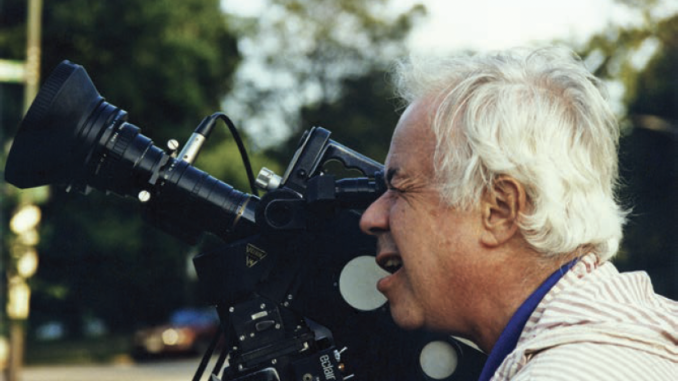
MARCH 2, 1931–JULY 16, 2024
Manny Kirchheimer contained multitudes: He was a filmmaker, an educator, a mentor, a friend, a husband, a father — and, in a role of which he was especially proud, an editor.
“He just loved the editing process,” his son Gabe Kirchheimer said in an interview with CineMontage. “I mean, he loved all of it. But he really loved editing.”
As an editor for hire, Kirchheimer, who died on July 16 at age 93, accumulated countless credits on television news and documentaries, but it was his adventuresome and intuitive editing of his own inimitable nonf iction f ilms of which he was proudest and for which he will be remembered.
“Manny’s films are unique and stylized,” said retired sound editor and sound supervisor Stuart Stanley, who studied under Kirchheimer and later worked with him. “His motion picture editorial style conveys a thematic visual canvas. The layering and the rhythms of the sound and music mix require interpretation. A Manny Kirchheimer film is not a spoon-fed affair. You are presented numerous varied ingredients and the viewer can pick and choose among those ingredients.”
Yet, like all great meals, Kirchheimer’s films required a master chef.
“Manny knew exactly what he wanted to assemble and achieve in the three-act structure of his film,” said longtime assistant editor William Kruzykowski, who also was a student of the filmmaker and became the production manager, second cameraman, still photographer, and assistant editor of “Stations of the Elevated,” released in 1981.
In that widely admired film, Kirchheimer trained his camera on the expressive, eye-catching works of graffiti that emblazoned many New York subway trains in the late 1970s and early ’80s.
“It was almost like Manny had the film already assembled in his mind,” Kruzykowski said. “He just needed to shoot it. Some locations that he selected were taken from a list of places that Manny had noticed in his travels riding in his car, and then made note of them with the intent to use them in a future film.”
With a penchant for urban subjects and settings, Kirchheimer also made films about an ocean liner in the process of docking (1965’s short “Colossus on the River”) and a trek across a suspension bridge (1975’s short “Bridge High”). Other films examined racial tensions (1973’s “Short Circuit”) and the life of the architect Louis Sullivan (2006’s “Tall: The American Skyscraper and Louis Sullivan”).
Manfred Alexander Kirchheimer was born to Jewish parents in Saarbrucken, Germany in 1931. Five years later, alert to increasing anti-Semitism in Nazi-controlled Germany, his father moved his family to the United States. Upon arriving in New York, the Kirchheimers made their home in Washington Heights.
In his acclaimed 1986 film “We Were So Beloved,” Kirchheimer turned his attention to his personal history, conducting interviews with Jews who, like his parents, had escaped Germany and began anew in New York.
Kirchheimer was introduced to filmmaking at City College of New York, where he earned a degree in 1952. Among his most consequential teachers was Dada painter and avant-garde filmmaker Hans Richter. “Hans Richter was a big influence for my dad,” Gabe Kirchheimer said.
“Hans Richter saw things a little differently, and I think that kind of piqued my dad’s interest in film. And then, right after my dad graduated, they hired him to teach.”
Thus Kirchheimer embarked on dual tracks, pursuing his own independent nonfiction film projects — mostly funded with his own resources — while earning a living by teaching at the New York Institute of Technology and the School of Visual Arts. By all accounts, Kirchheimer was an engaged and engaging teacher who transmitted to his students a love for and appreciation of film in all its forms.
“He was a legendary instructor,” Gabe Kirchheimer said. “He has legions of former students.”
Among those students was Stuart Stanley, who recalled meeting Kirchheimer during his “one and only semester as a film student” at New York Tech.
“My first day of class was an epiphany for me, and Manny immediately became my mentor,” said Stanley, who, under Kirchheimer, learned the basics of film production, sound recording, and editing.
“Manny asked me to be in charge of the film equipment. I distributed cameras, recorders, lights, and you name it to the students,” Stanley said. “He also allowed me to commute to New York and learn how to repair Moviola editing machines at Laumic Company, the largest editorial rental and repair facility in New York City at that time.”
When he made his first student film, Stanley found Kirchheimer to be unfailingly encouraging — even when Stanley himself had developed misgivings about his own project. “He said, ‘Your wonderful film is your personal project, and you must come to terms with it,’” Stanley recalled.
“Manny was unlike anyone I had ever met,” Stanley said. “He was so gentle, soft-spoken, acutely attuned to the needs of others while never demanding attention. He didn’t push, prod, steer, manipulate, coerce, or raise his voice. He allowed his students the freedom of creativity without interference.”
Stanley, who was later recruited to work on “Stations of the Elevated,” was not alone among Kirchheimer’s students who were pressed into practical filmmaking service.
“Even though his movies basically had no budget, it would all be his own money most of the time,” said Gabe Kirchheimer, adding that his father also received grants from the National Endowment for the Arts and National Endowment for the Humanities. In 2016, he became the recipient of a Guggenheim Fellowship.
Kruzykowski, the student who also found himself working on “Stations of the Elevated,” remembers first hearing about the film over lunch with the filmmaker at the New York Institute of Technology.
“He eventually asked me if I was interested in helping him shoot it,” Kruzykowski said. “To my recollection, Manny never showed me a script or outline. He just talked about the underlying meaning and purpose of making this new film. It intrigued me because of the simplicity in his proposed use of imagery, sound effects, and music — and no voice-over, narration, or sync-sound dialogue — that would be the core of his film.”
Kirchheimer maintained a sideline as an editor on network television projects, especially in the 1960s and ’70s. “He worked for all three alphabet networks and for WNET,” Gabe Kirchheimer said.
“He worked on an astronomical number of films — over a hundred for the networks.” Despite his success in this realm, Kirchheimer regarded these assignments simply as jobs; occasionally, he found himself engaged in a project that related to social-justice issues, such as inner-city public schools.
But he most enjoyed editing his own work — even with the delays and uncertainty to be expected in genuinely independent filmmaking.
“There were some very difficult periods when he didn’t have enough work,” Gabe Kirchheimer said. “I think that’s one of the reasons why these films took as long as they did to finish — just to deal with the mix and all the labs.”
Kirchheimer embraced the arrival of digital editing, which enabled him to pick up the pace of his filmmaking craft toward the waning days of his career. His later films include “Spraymasters” (2007), “Art Is … The Permanent Revolution” (2012), and “My Coffee with Jewish Friends” (2017).
“In the old days, it would take him years to complete a film,” Gabe Kirchheimer said. “Then he learned to use the digital stuff and got a Final Cut 7 system at the house that he used until the end.”
Kirchheimer is survived by his wife, Gloria, and their sons, Gabe and Daniel.
— Peter Tonguette



